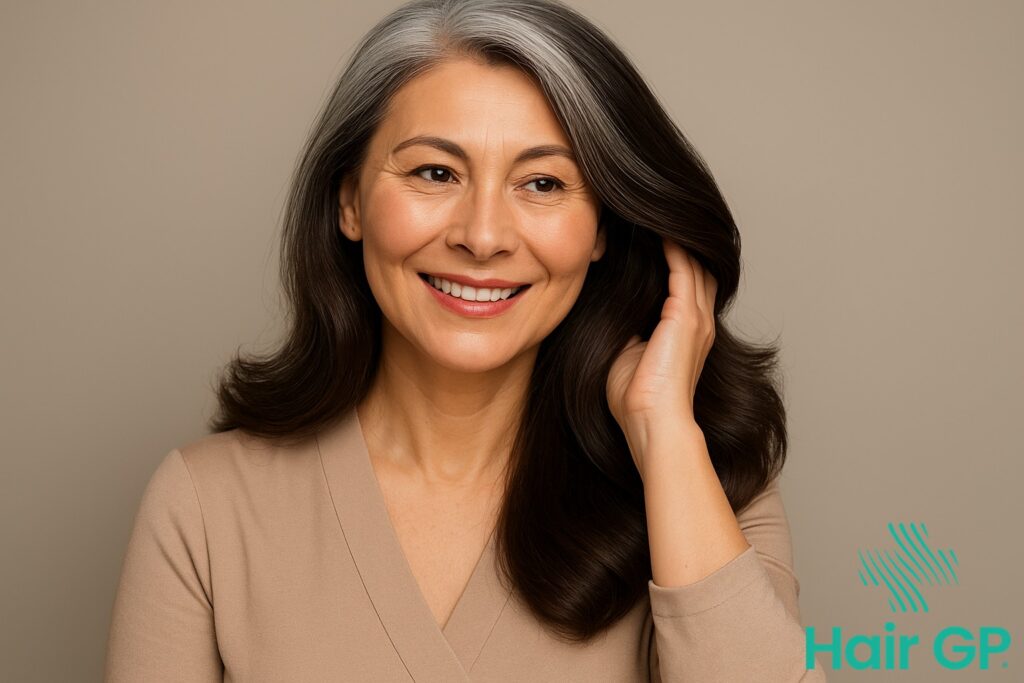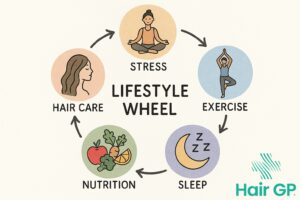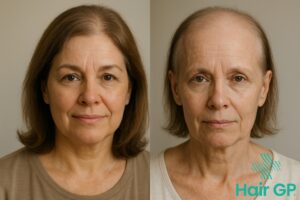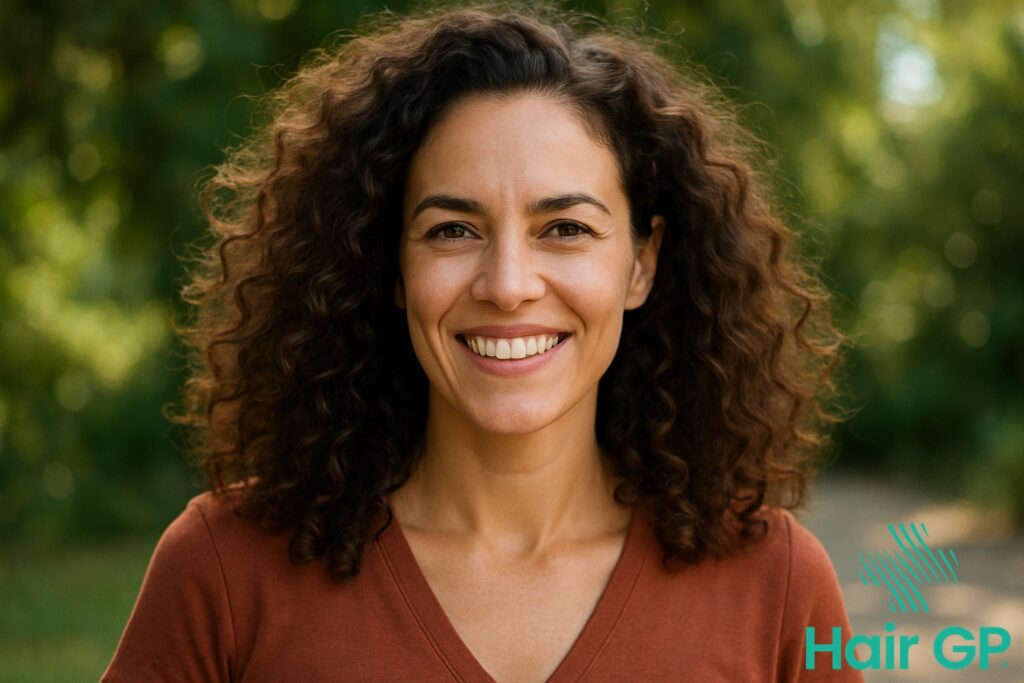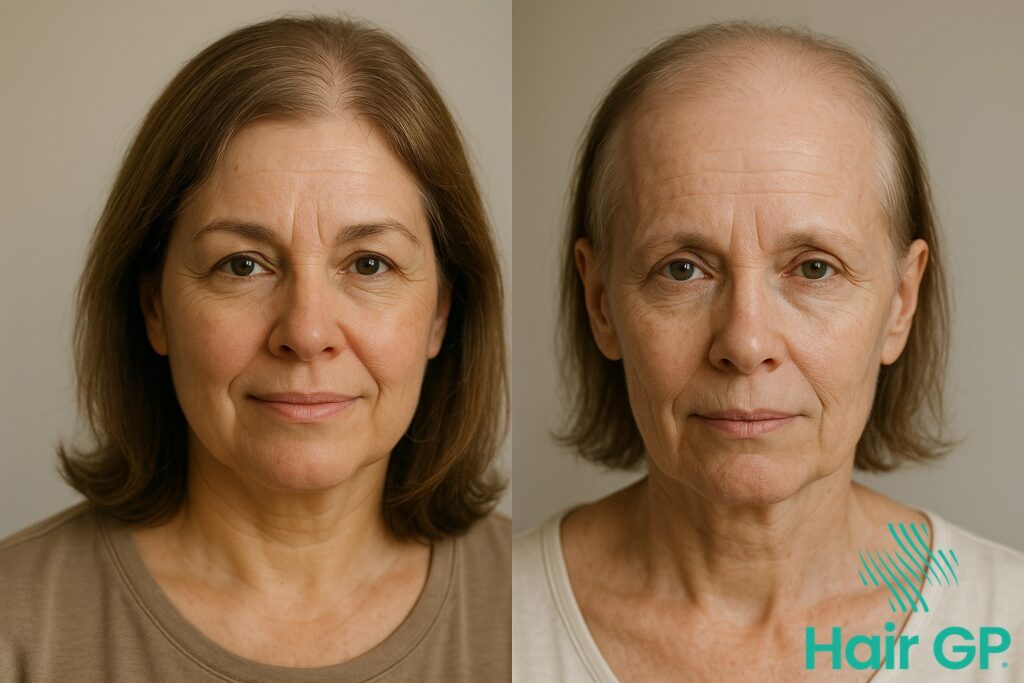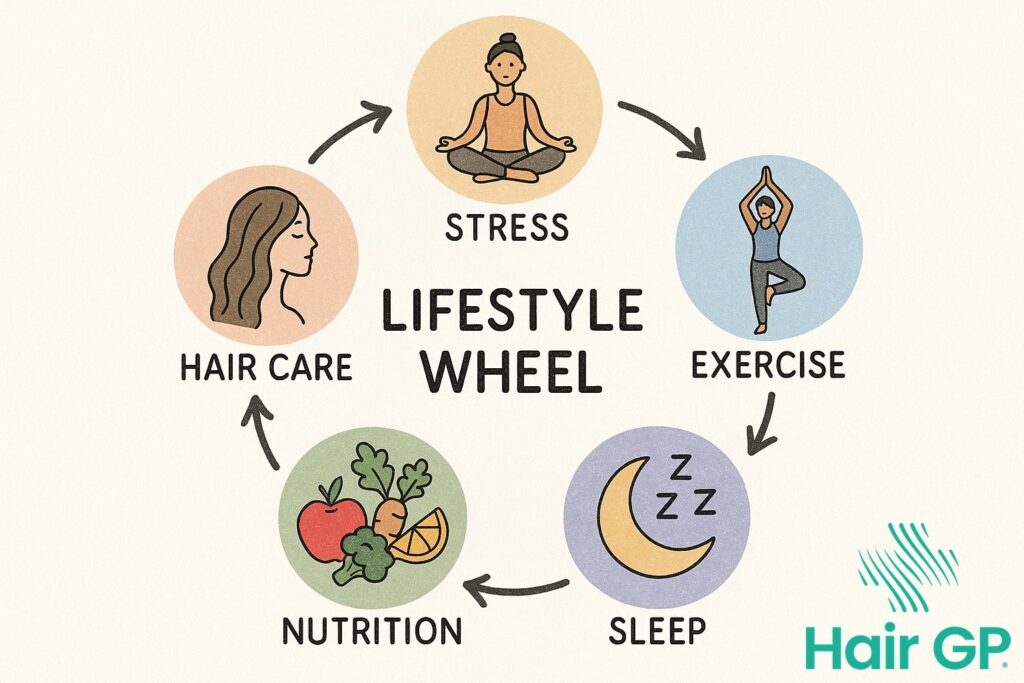Introduction
For many women, the first signs of menopause hair changes can be alarming. Once-thick locks may feel thinner, previously manageable hair becomes dry and brittle, and styling routines that worked for decades suddenly seem ineffective. If you’re experiencing these hair changes during perimenopause or menopause, you’re not alone – these transformations affect up to 40% of women during this life transition.
Menopause hair loss and texture changes stem from complex hormonal shifts that directly impact hair health. As oestrogen levels decline and androgen activity increases, your hair follicles respond by producing finer, more fragile strands. These menopausal symptoms extend beyond simple thinning, affecting everything from hair texture to growth patterns.
This comprehensive guide explores the science behind hormonal hair changes, helping you understand exactly what’s happening to your hair during menopause. You’ll discover the most common hair problems women face, learn how hormonal fluctuations affect follicle function, and find practical solutions for maintaining healthy hair. From building an effective daily care routine to exploring professional treatments and medical options, we’ll provide evidence-based strategies to help you navigate these changes with confidence and achieve the best possible hair health during menopause and beyond.
Key Takeaways – TL/DR
- Declining oestrogen levels during menopause directly impact hair growth cycles and texture
- Hair thinning, dryness, and texture changes are common but manageable with proper care
- A targeted hair care routine with gentle products can significantly improve hair health
- Professional treatments like HRT and minoxidil can help with severe hair loss
- Nutrition and stress management play crucial roles in maintaining healthy hair during menopause
Understanding Menopause Hair Changes
During menopause, significant hormonal changes directly impact the hair cycle, leading to noticeable alterations in hair texture and density. As oestrogen levels decline, hair follicles become increasingly sensitive to androgens, potentially triggering androgenetic alopecia in genetically predisposed women[1]. This hormonal shift disrupts the normal hair growth cycle, causing follicles to spend less time in the anagen (growth) phase and more time in the telogen phase, where hair rests before shedding.
The science behind these changes reveals that oestrogen plays a protective role in maintaining hair thickness and promoting sustained growth. When oestrogen decreases, hair follicles miniaturise, producing progressively finer strands[2]. Additionally, reduced sebum production leads to drier, more brittle hair that breaks easily. The hair cycle typically shortens from its usual 2-7 year growth phase to a significantly reduced period, resulting in shorter maximum hair length. These biological mechanisms explain why many women experience not only hair loss but also changes in texture, with previously smooth hair becoming coarse or wavy, and thick hair becoming noticeably thinner and more fragile.
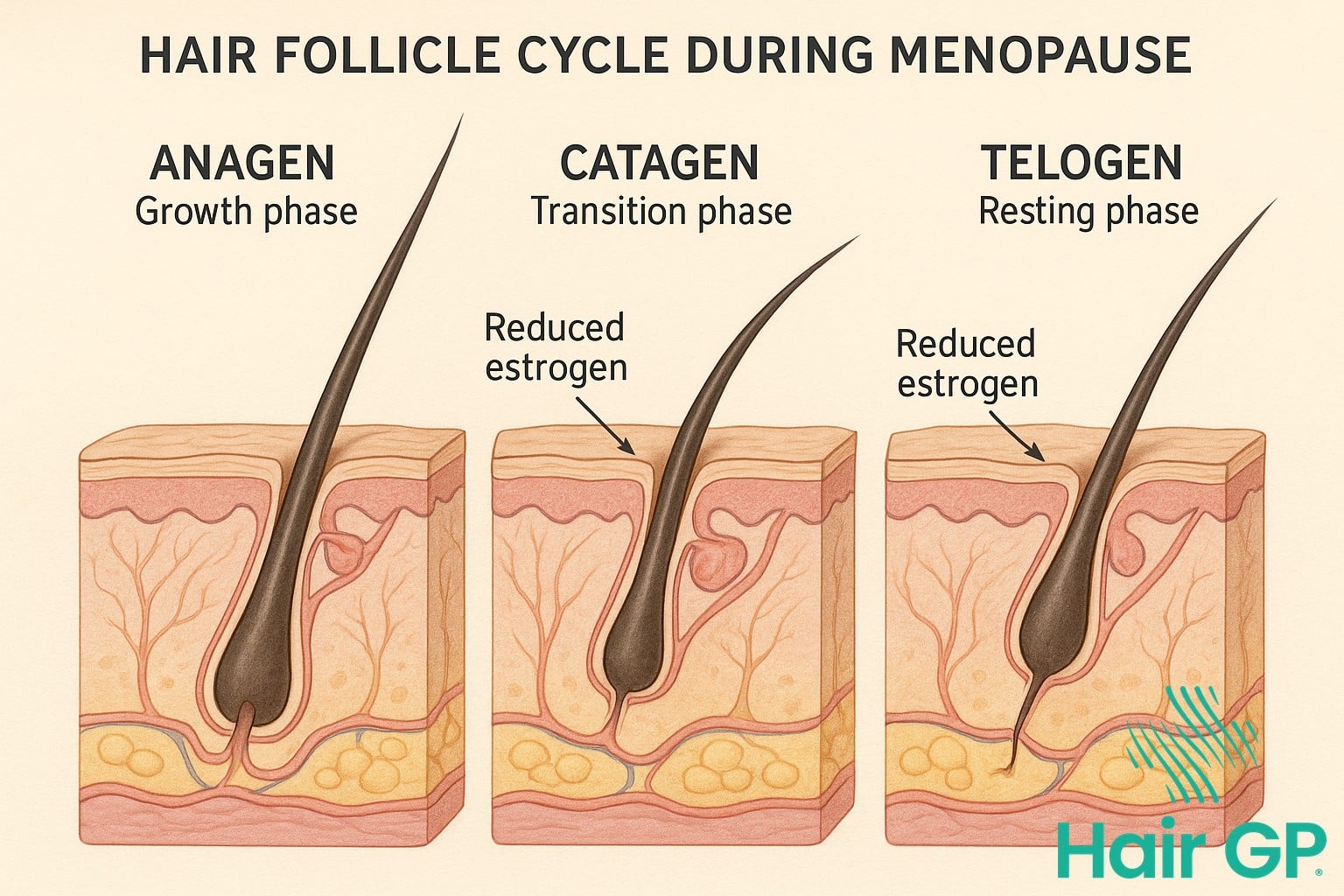
Common Hair Problems During Menopause
During menopause, many women notice significant changes in their hair’s appearance and feel. Understanding these common problems can help you recognise symptoms early and take appropriate action to maintain healthy hair throughout this transition.
Hair Thinning and Volume Loss
Female pattern hair loss affects approximately 40% of women by age 50[1], making hair thinning one of the most prevalent menopausal concerns. This occurs through hair follicle miniaturisation, where follicles gradually produce finer, shorter strands. You might notice widening part lines, particularly at the crown, and overall volume reduction that makes styling more challenging. Unlike male pattern baldness, women typically experience diffuse thinning across the scalp rather than distinct bald patches.
Texture and Moisture Changes
Declining oestrogen levels reduce sebum production, leaving previously manageable hair feeling dry and brittle. This moisture loss often leads to increased porosity and cuticle damage, creating a rough hair texture that’s prone to tangling. Many women report their hair becoming unexpectedly frizzy or coarse, whilst grey hair emerges with a different structure that can feel wiry and resistant to styling products.
Hormonal Impact on Hair Health
During menopause, hormonal changes trigger significant alterations in hair follicle function. Oestrogen levels decline by up to 60% within five years of the final menstrual period[3], while androgens remain relatively stable, creating an imbalanced hormonal environment. This shift particularly affects menopausal women experiencing concurrent symptoms like hot flashes.
The relative increase in androgens allows dihydrotestosterone (DHT) to exert stronger effects on hair follicles. DHT binds to androgen receptors, progressively miniaturising follicles and shortening the anagen (growth) phase[4]. This process particularly impacts the scalp’s crown and frontal regions, where androgen-sensitive follicles predominate.
These hormonal fluctuations can trigger telogen effluvium, pushing numerous follicles simultaneously into the resting phase. While HRT may help stabilise hormone levels and potentially slow hair changes, individual responses vary considerably based on genetic predisposition and the specific hormonal profile of each woman during this transition.
Essential Hair Care Routine for Menopausal Hair
Creating an effective hair care routine during menopause requires gentle approaches tailored to your hair’s changing needs. With the right hair care products and techniques, you can maintain strength, moisture, and vitality whilst protecting fragile strands.
Gentle Cleansing and Conditioning
Choose gentle shampoo formulations that cleanse without stripping natural oils, essential for maintaining a healthy scalp. Incorporate weekly deep conditioning treatments to restore moisture and elasticity to dry, brittle hair. Massage your scalp gently during washing to stimulate circulation and support follicle health.
Styling Tips for Fragile Hair
Minimise heat styling damage by applying thermal protection sprays before using tools on low-temperature settings. Use wide-toothed combs and natural bristle brushes, starting from ends and working upwards to keep hair smooth without breakage. Consider protective hairstyles like loose braids or silk scrunchie ponytails that reduce tension on delicate strands. When possible, allow hair to air-dry partially before finishing with minimal heat to preserve moisture and prevent additional stress on already fragile hair.
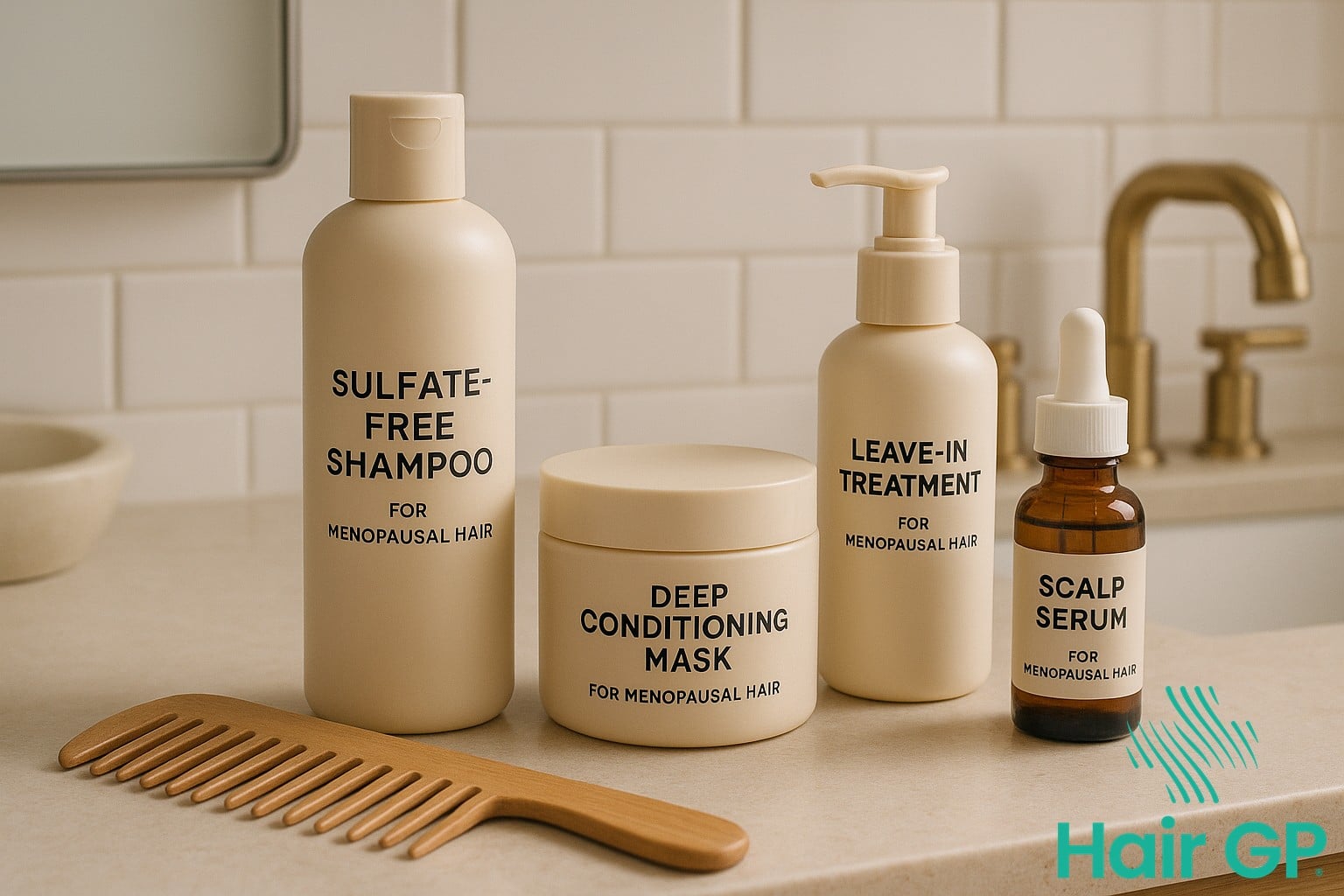
Professional Treatments and Medical Options
Professional medical interventions offer evidence-based solutions for menopausal hair concerns. Hormone replacement therapy (HRT) can effectively address thinning by restoring oestrogen levels, with studies showing improved hair density and follicle health in postmenopausal women[5]. This systemic approach helps stimulate hair growth by counteracting the hormonal imbalances that trigger follicular miniaturisation.
Topical minoxidil remains the gold standard for promoting healthy hair growth, with clinical trials demonstrating significant improvements in hair volume when applied consistently[6]. Professional salon treatments, including scalp micropigmentation and laser therapy, complement medical approaches by enhancing circulation and creating optimal conditions for more hair production. Women experiencing progressive hair loss should consult healthcare providers when shedding exceeds 100 strands daily or visible scalp becomes apparent, ensuring timely intervention before permanent follicular damage occurs.
Conclusion
Understanding and addressing menopause hair changes requires a proactive approach tailored to your specific hair type. Whether you’re dealing with fine hair, increased hair breakage, or other hair issues, the strategies discussed throughout this guide offer practical solutions for maintaining healthy hair. Remember that hormonal fluctuations are temporary, and with the right care routine, nutritional support, and professional guidance, you can effectively manage these changes. Take action today by implementing these evidence-based approaches, and don’t hesitate to seek professional help when needed. Your hair’s health during menopause is entirely manageable with the right knowledge and tools.
Frequently Asked Questions
Yes, menopause can trigger sudden hair loss due to rapid hormonal changes. This type of hair loss, called telogen effluvium, occurs when many hair follicles enter the resting phase simultaneously. While alarming, it’s usually temporary and improves with proper treatment.
Hair texture changes during menopause can be long-lasting but not necessarily permanent. With proper care, nutrition, and sometimes medical intervention, you can improve hair texture significantly. Some women find their hair remains different from pre-menopause but still healthy.
Prevent frizzy hair by using moisturizing shampoos and conditioners, applying leave-in treatments, avoiding heat styling, using a silk pillowcase, and incorporating hair masks weekly. Humidity-blocking products and gentle styling techniques also help tame frizz effectively.
Hair thinning during menopause can often be improved, though complete reversal depends on the cause. Early intervention with proper hair care, nutrition, stress management, and medical treatments like minoxidil or HRT can help regrow hair and prevent further loss.
References
- Grymowicz M, Rudnicka E, Podfigurna A, et al. Hormonal Effects on Hair Follicles. Int J Mol Sci. 2020;21(15):5342.
- Mirmirani P. Hormonal changes in menopause: do they contribute to a ‘midlife hair crisis’ in women? Br J Dermatol. 2011;165(Suppl 3):7-11.
- Santoro N, Roeca C, Peters BA, Neal-Perry G. The Menopause Transition: Signs, Symptoms, and Management Options. J Clin Endocrinol Metab. 2021;106(1):1-15.
- Grymowicz M, Rudnicka E, Podfigurna A, et al. Hormonal Effects on Hair Follicles. Int J Mol Sci. 2020;21(15):5342.
- Rozner RN, Freites-Martinez A, Shapiro J, et al. Safety of 5α-reductase inhibitors and spironolactone in breast cancer patients receiving endocrine therapies. Breast Cancer Res Treat. 2019;174(1):15-26.
- Blume-Peytavi U, Hillmann K, Dietz E, et al. A randomized, single-blind trial of 5% minoxidil foam once daily versus 2% minoxidil solution twice daily in the treatment of androgenetic alopecia in women. J Am Acad Dermatol. 2011;65(6):1126-1134.

